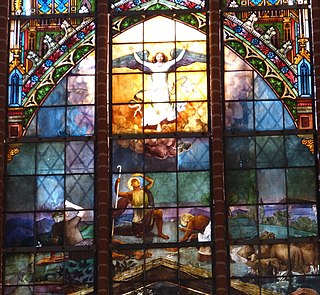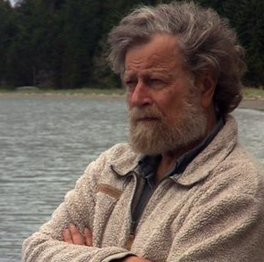Related Research Articles

John Milford Rutter is an English composer, conductor, editor, arranger, and record producer, mainly of choral music.
Patrick Larley is a British composer.
Egil Hovland was a Norwegian composer.
Kenneth L. Jennings was an American choral conductor and composer. He was the Harry R. and Thora Helseth Tosdal Professor of Music Emeritus and Director Emeritus of the St. Olaf Choir. He was a published arranger, composer, and choral music educator.

Michael Philip McGlynn is an Irish composer, producer, director, and founder of the vocal ensemble Anúna.

Daniel Ernest Forrest Jr. is an American composer, pianist, educator, and music editor.

Angels' Carol is a popular sacred choral piece by John Rutter for Christmas. He wrote his own text, beginning "Have you heard the sound of the angel voices", three stanzas with the refrain "Gloria in excelsis Deo". It has been part of recordings of collections of Christmas music, including one conducted by the composer.
Steven Sametz is active as both conductor and composer. He has been hailed as "one of the most respected choral composers in America." Since 1979, he has been on the faculty of Lehigh University in Bethlehem, Pennsylvania, where he holds the Ronald J. Ulrich Chair in Music and is Director of Choral Activities and is founding director of the Lehigh University Choral Union. Since 1998, he has served as Artistic Director of the professional a cappella ensemble, The Princeton Singers. He is also the founding director of the Lehigh University Summer Choral Composers’ Forum. In 2012, he was named Chair of the American Choral Directors Association Composition Advisory Committee.
"The Lord bless you and keep you" is a classical sacred choral composition by Peter Lutkin, later adapted by John Rutter, based on Numbers 6:24-26. It is a setting of a biblical benediction, followed by an extended "Amen". Rutter scored the piece for four vocal parts (SATB) and organ. He composed it in 1981 for the memorial service of Edward T. Chapman, the director of music at Highgate School, London, with whom he had studied when he attended the school.

The Magnificat by John Rutter is a musical setting of the biblical canticle Magnificat, completed in 1990. The extended composition in seven movements "for soprano or mezzo-soprano solo, mixed choir, and orchestra " is based on the Latin text, interspersed with "Of a Rose, a lovely Rose", an anonymous English poem on Marian themes, the beginning of the Sanctus and a prayer to Mary. The music includes elements of Latin American music.
"I will sing with the spirit" is a sacred choral composition by John Rutter. The biblical text is taken from 1 Corinthians 14:15, adding to the second half of the verse an often repeated "alleluia". Rutter scored the piece for four vocal parts (SATB) and organ, adding other versions. He composed it in 1994 for the Royal School of Church Music in England.
André Jerome Thomas is an American composer and conductor. He served as a professor of music at the College of Music at Florida State University and the artistic director for the Tallahassee Community Chorus. In addition to his conducting and composition credits, Thomas is a published author, having written Way Over in Beulah Lan': Understanding and Performing the Negro Spiritual, and numerous journal articles.
Jake Runestad is an American composer and conductor of classical music based in Minneapolis, Minnesota. He has composed music for a wide variety of musical genres and ensembles, but has achieved greatest acclaim for his work in the genres of opera, orchestral music, choral music, and wind ensemble. One of his principal collaborators for musical texts has been Todd Boss.

Te Deum is a sacred choral composition by Karl Jenkins, written in 2008. It is an extended setting of the Te Deum in Latin. Te Deum is often performed together with the composer's Gloria.
The Lord Is My Shepherd is a sacred choral composition by John Rutter, a setting of Psalm 23. The work was published by Oxford University Press in 1978. Marked "Slow but flowing", the music is in C major and 2/4 time. Rutter composed it for Mel Olson and the Chancel Choir of the First United Methodist Church in Omaha, Nebraska. He later included the work as a movement in his Requiem of 1985, then with orchestra or chamber ensemble. In 1993, Rutter also made it part of his Psalmfest, a collection of nine psalms written over 20 years. For that version, he used also soloists.

Michael John Trotta is an American musical composer and conductor. He has appeared at Carnegie Hall three times since 2014.
"For the beauty of the earth" is a sacred choral composition by John Rutter, a setting of the hymn of the same name by Folliott S. Pierpoint. The work was published by Oxford University Press in 1980. Recorded several times, it has been described as "one of Rutter's more popular, enduring anthems".

Ave Maria is a 1964 motet by Franz Biebl, composed for double choir, a large four-part choir and a three-part choir which can be performed by soloists. It is a setting of part of the Latin liturgical Angelus prayer, which contains the Ave Maria as a refrain. The composition was originally written for men's chorus, but the composer wrote arrangements for mixed choir and women's choir. The work and arrangements were published by Wildt's Musikverlag, first in 1964. The piece first became famous when a U.S. group, the Cornell University Glee Club, included it in their Christmas programs, and more famous when the Chanticleer ensemble made it part of their regular repertoire. It was published in the U.S. by Hinshaw and became one of the publisher's best-selling items.

O magnum mysterium is a motet for choir a cappella by Morten Lauridsen. He set the text of "O magnum mysterium", a Gregorian chant for Christmas, in 1994. The composition, performed and recorded often, made Lauridsen famous. It was described as expressive ethereal sounds in imperturbable calmness.
Godfrey Sampson was an English composer and organist, best remembered for his church and choral music.
References
- 1 2 3 4 "A Gaelic Blessing" (PDF). Warriner Choral Society. Archived from the original (PDF) on 2016-10-11. Retrieved 3 July 2016.
- 1 2 Dickey, Timothy. "John Rutter / A Gaelic Blessing ("Deep Peace"), for chorus & orchestra". AllMusic . Retrieved 3 July 2016.
- 1 2 Fiona Macleod. (1910). The Dominion of Dreams, Under the Dark Star. p.424 , Retrieved from [archive.org](https://archive.org/details/dominionofdreams0000fion)
- 1 2 3 Sharp, William (1911). The Dominion of Dreams: Under the Dark Star. New York: Duffield and Company. p. 423.
 This article incorporates text from this source, which is in the public domain .
This article incorporates text from this source, which is in the public domain . - 1 2 McPherson, Thomas (2017). Essential Celtic Prayers. Brewster, MA: Paraclete Press.
- ↑ "Anthem Notes for June 7, 2015 / A Gaelic Blessing" (PDF). NPC Tucson. 7 June 2015. Archived from the original (PDF) on 28 March 2016. Retrieved 3 July 2016.
- ↑ "A Gaelic Blessing". kempke.com. Retrieved 3 July 2016.
- ↑ "John Rutter / A Gaelic Blessing". Oxford University Press . Retrieved 6 July 2016.
- ↑ "Rutter: A Gaelic blessing (SATB compatible with A0288)". Royal School of Church Music . Retrieved 3 July 2016.
- ↑ "Gloria / The sacred music of John Rutter". collegium.co.uk. Retrieved 11 January 2014.
- ↑ "A Gaelic blessing". Hyperion . Retrieved 3 July 2016.